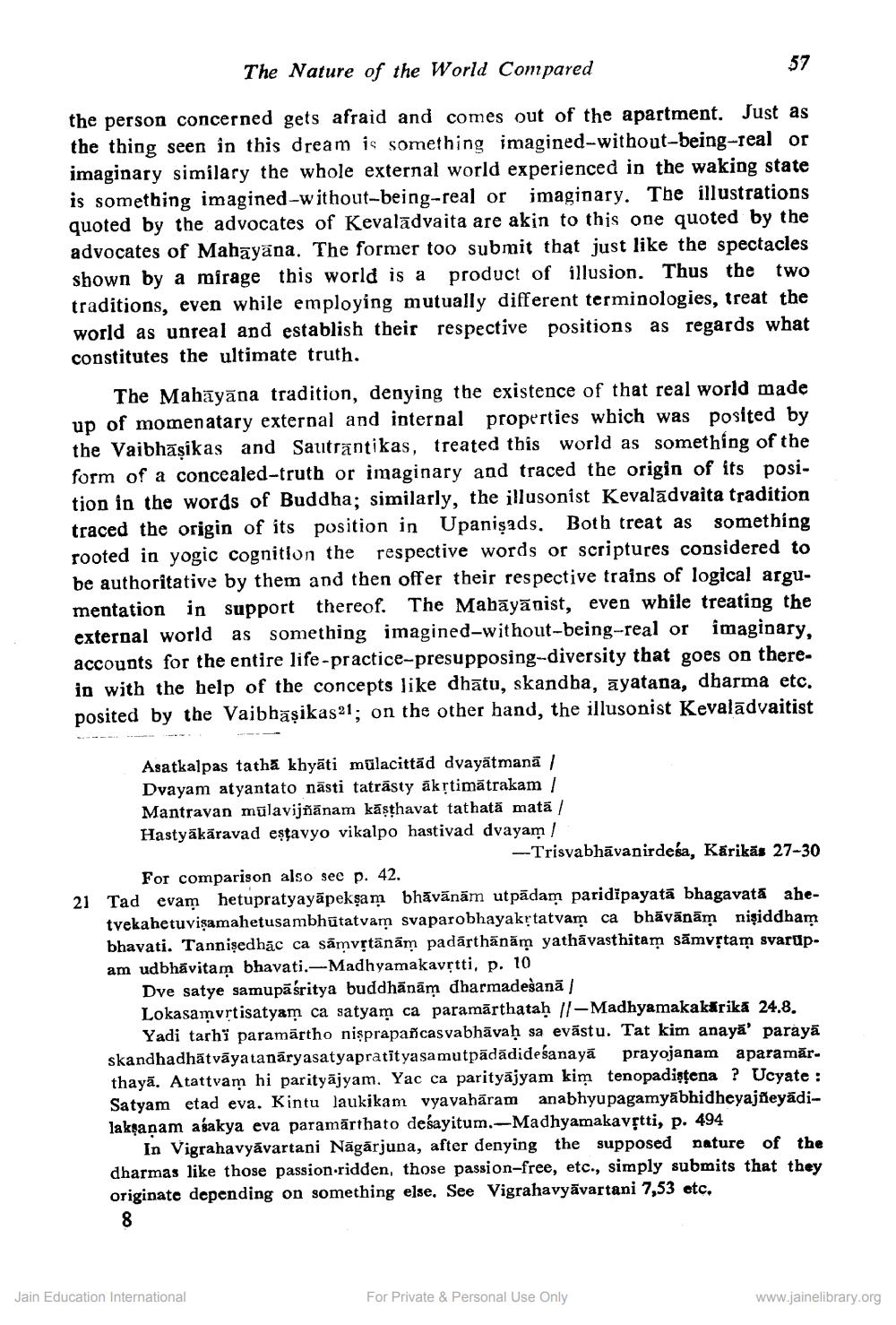________________
The Nature of the World Compared
the person concerned gets afraid and comes out of the apartment. Just as the thing seen in this dream is something imagined-without-being-real or imaginary similary the whole external world experienced in the waking state is something imagined-without-being-real or imaginary. The illustrations quoted by the advocates of Kevaladvaita are akin to this one quoted by the advocates of Mahayana. The former too submit that just like the spectacles shown by a mirage this world is a product of illusion. Thus the two traditions, even while employing mutually different terminologies, treat the world as unreal and establish their respective positions as regards what constitutes the ultimate truth.
The Mahayana tradition, denying the existence of that real world made up of momenatary external and internal properties which was posited by the Vaibhaṣikas and Sauträntikas, treated this world as something of the form of a concealed-truth or imaginary and traced the origin of its position in the words of Buddha; similarly, the illusonist Kevaladvaita tradition something traced the origin of its position in Upanisads. Both treat as rooted in yogic cognition the respective words or scriptures considered to be authoritative by them and then offer their respective trains of logical argumentation in support thereof. The Mahāyānist, even while treating the imaginary, external world as something imagined-without-being-real or accounts for the entire life-practice-presupposing-diversity that goes on therein with the help of the concepts like dhātu, skandha, ayatana, dharma etc. posited by the Vaibhaṣikas21; on the other hand, the illusonist Kevaladvaitist
Asatkalpas tatha khyāti mulacittad dvayatmanā / Dvayam atyantato nästi tatrasty akṛtimatrakam / Mantravan mulavijñānam kāṣṭhavat tathata matā / Hastyäkäravad estavyo vikalpo hastivad dvayam /
57
-Trisvabhavanirdesa, Karikas 27-30
For comparison also see p. 42.
21 Tad evam hetupratyayāpekṣam bhāvānām utpādam paridipayata bhagavata ahetvekahetuviṣamahetusambhūtatvam svaparobhayakṛtatvam ca bhāvanām nisiddham bhavati. Tanniṣedhac ca samvṛtānām padarthanam yathavasthitam samvṛtam svarupam udbhävitam bhavati.-Madhyamakavṛtti, p. 10
Dve satye samupäśritya buddhanam dharmadesanā /
Lokasamvṛtisatyam ca satyam ca paramarthataḥ //-Madhyamakakarika 24.8. Yadi tarhi paramartho nisprapañcasvabhavaḥ sa evästu. Tat kim anaya' paraya skandhadhätvāyatanaryasatyapratītyasamutpādādideśanaya prayojanam aparamăr. thaya. Atattvam hi parityajyam. Yac ca parityajyam kim tenopadistena? Ucyate : Satyam etad eva. Kintu laukikam vyavahāram anabhyupagamyābhidheyajñeyādilakṣaṇam aśakya eva paramarthato deśayitum.-Madhyamakavṛtti, p. 494
In Vigrahavyavartani Nāgārjuna, after denying the supposed nature of the dharmas like those passion-ridden, those passion-free, etc., simply submits that they originate depending on something else. See Vigrahavyavartani 7,53 etc.
8
Jain Education International
For Private & Personal Use Only
www.jainelibrary.org




